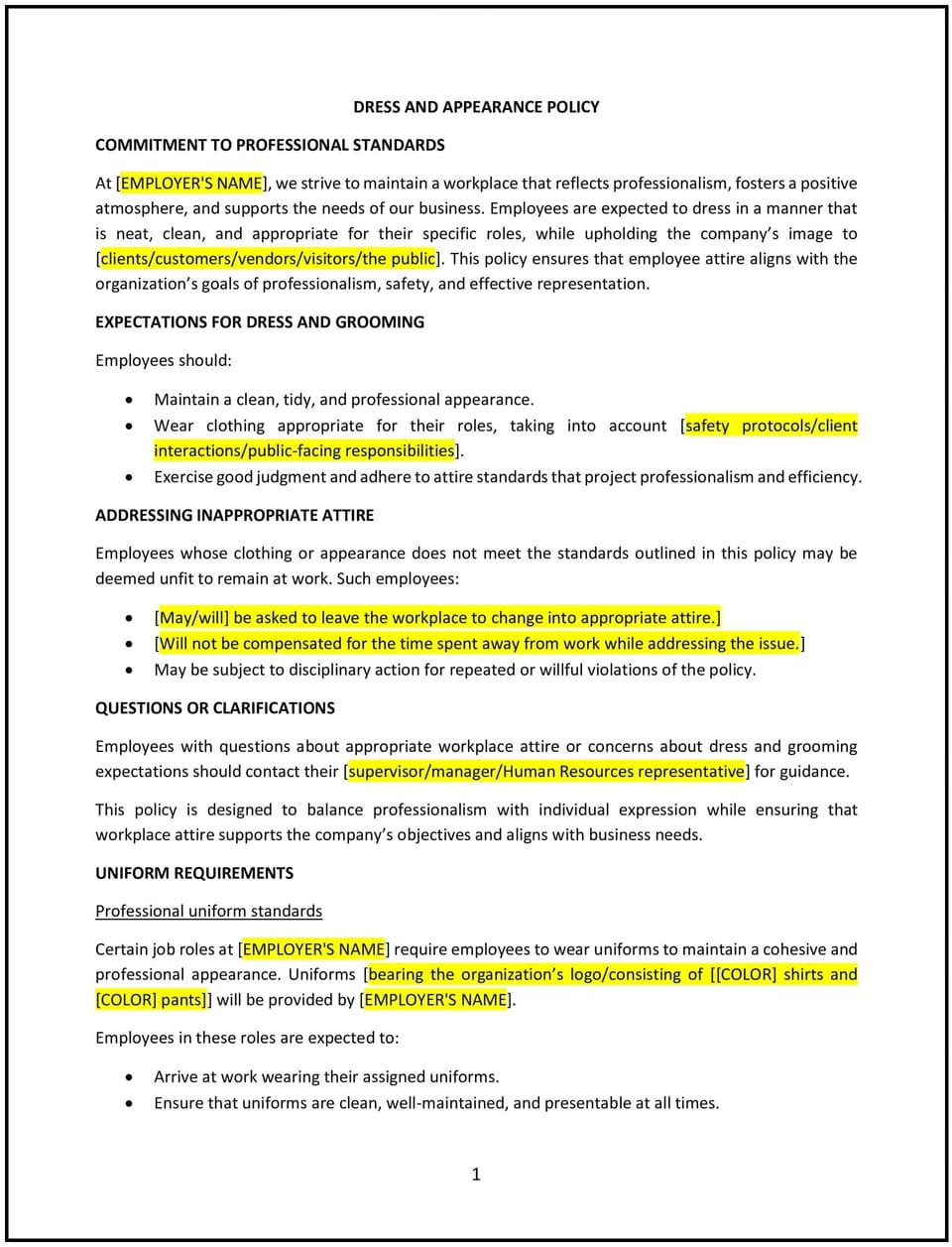Dress and appearance policy (Oklahoma): Free template

Dress and appearance policy (Oklahoma)
This dress and appearance policy is designed to help Oklahoma businesses establish clear guidelines for employee attire and grooming. The policy outlines dress code expectations, industry-specific requirements, and accommodations for religious or medical needs to maintain a professional workplace environment.
By implementing this policy, businesses can ensure consistency, promote a positive company image, and balance professionalism with employee comfort.
How to use this dress and appearance policy (Oklahoma)
- Define dress code expectations: Specify whether the dress code is business formal, business casual, or includes uniforms.
- Address industry-specific requirements: Outline any safety gear or specialized attire needed for certain roles.
- Allow reasonable accommodations: Provide flexibility for religious, cultural, or medical dress code exemptions.
- Set grooming and hygiene standards: Ensure employees maintain a clean, professional appearance appropriate for the workplace.
- Outline seasonal or role-based variations: Specify if different attire is allowed based on seasons or job functions.
- Implement an enforcement process: Detail how non-compliance will be addressed, including corrective actions.
- Review regularly: Assess the policy periodically to reflect changing workplace norms and Oklahoma-specific business considerations.
Benefits of using this dress and appearance policy (Oklahoma)
Implementing this policy provides several advantages for Oklahoma businesses:
- Enhances company image: Promotes a professional and consistent workplace appearance.
- Ensures workplace safety: Establishes attire requirements for roles involving hazardous tasks.
- Reduces misunderstandings: Provides clear expectations for employee dress and grooming.
- Encourages inclusivity: Allows accommodations for religious and cultural dress practices.
- Reflects Oklahoma-specific workplace norms: Aligns with local business expectations and industry standards.
Tips for using this dress and appearance policy (Oklahoma)
- Communicate expectations clearly: Ensure employees understand what is considered appropriate workplace attire.
- Offer flexibility when possible: Allow dress code adjustments for comfort while maintaining professionalism.
- Address enforcement consistently: Apply dress code rules fairly to all employees.
- Consider branding: Align dress code policies with the company’s branding and industry image.
- Update as needed: Modify the policy based on workplace culture, seasonal needs, or industry trends.
Q: What type of dress code should businesses implement?
A: Businesses should choose a dress code that aligns with their industry, whether business formal, business casual, uniforms, or safety attire.
Q: Can employees request exemptions from the dress code?
A: Yes, businesses should allow exemptions for religious, cultural, or medical reasons when reasonable.
Q: How should businesses enforce the dress code?
A: Businesses should provide employees with clear guidelines, address violations discreetly, and implement corrective measures when necessary.
Q: Can businesses require employees to wear uniforms?
A: Yes, businesses can require uniforms if they are necessary for branding, safety, or role-based requirements.
Q: Are different dress codes allowed for different roles?
A: Yes, businesses should specify if dress code expectations vary by job function, department, or client-facing roles.
Q: How should businesses handle dress code violations?
A: Businesses should address dress code violations professionally and consistently, starting with a reminder before taking formal action.
Q: How often should this policy be reviewed?
A: The policy should be reviewed annually or as needed to reflect workplace changes and Oklahoma-specific business practices.
This article contains general legal information and does not contain legal advice. Cobrief is not a law firm or a substitute for an attorney or law firm. The law is complex and changes often. For legal advice, please ask a lawyer.


